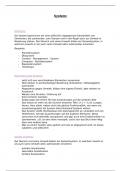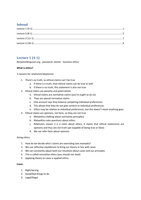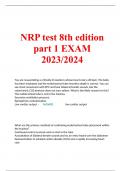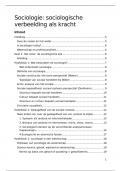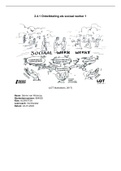Table of Contents
1. The Financial Crisis (Week 19) .................................................................................... 2
1.1. The financial sector........................................................................................................ 2
1.2. The global financial crisis 2007-9.................................................................................... 2
1.3. Policy responses ............................................................................................................ 4
1.4. Policies to prevent the crisis .......................................................................................... 4
1.5. The role of central banks ............................................................................................... 4
1.6. Lessons learned ............................................................................................................. 5
2. The Aftermath of the Financial Crisis (Week 20) ......................................................... 5
2.1. Hypothesis in financial economics ................................................................................. 5
2.1.1. Efficient market hypothesis versus irrational exuberance ............................................................. 5
2.1.2. Financial instability hypothesis ...................................................................................................... 6
2.1.3. Financial accelerator ...................................................................................................................... 6
2.2. Sovereign debt crisis ...................................................................................................... 7
2.3. Evaluation of austerity policies ...................................................................................... 8
, 1. The Financial Crisis (Week 19)
1.1. The financial sector
• Risks of the financial system:
o Default Risk – End-Borrowers defaulting on loans from the bank.
o Liquidity Risk – The inability of a bank to turn its assets into cash when the savers
want their deposits back. This is because they turn liquid deposits (cash) into illiquid
loans that they give to borrowers.
o To cover these risks, banks must have reserves (assets) and equity (liability), that are
recorded in their balance sheet.
• Adverse shock – Adverse shocks can occur to borrowers that may make them default on their
loan payments. These shocks might be amplified even further, possibly leading to two spirals:
o Liquidity spiral (asset side) – financial stability.
§ A negative shock on borrowers increases defaults → banks credit decreases
→ equity decreases to cover the credit loss → the equity decreases in % terms
by much more than assets → the leverage ratio falls.
§ Leverage Ratio = Asset to Equity Ratio. It describes a bank’s ability to
withstand negative shocks.
§ The response by the bank is to deleverage: Reduce new credit and fire sell
assets → this causes asset prices to drop. In turn, this causes the banks to lose
more equity, so they are forced to sell more assets and so on.
o Debt disinflation spiral (liability side) – price stability.
§ As banks shrink the balance sheet by selling assets, the supply of inside money
declines and therefore the money multiplier declines.
§ Households are now exposed to more risks, so the money demand increases
but total money supply declines due to banks decreasing their balance sheet.
Hence, the value of money rises (disinflation).
§ Disinflation → the real value of savers deposits increases (so banks owe more
money to savers) → banks equity decreases, and leverage ratio further
decreases.
o Paradox of prudence – each bank reduces its own risk. In turn, this increases the
overall systemic macro risk.
1.2. The global financial crisis 2007-9
• The boom of the late eighties gave way to recession in the early 1990s and then to a period of
reduces volatility, known as the Great Moderation.
• The Financial Crisis, from 2007 to 2009, led to a widespread and deep global recession.
• Some of the main causes of the crisis:
o Financial deregulation – rules and regulations surrounding the activities of banks
were relaxed.
1. The Financial Crisis (Week 19) .................................................................................... 2
1.1. The financial sector........................................................................................................ 2
1.2. The global financial crisis 2007-9.................................................................................... 2
1.3. Policy responses ............................................................................................................ 4
1.4. Policies to prevent the crisis .......................................................................................... 4
1.5. The role of central banks ............................................................................................... 4
1.6. Lessons learned ............................................................................................................. 5
2. The Aftermath of the Financial Crisis (Week 20) ......................................................... 5
2.1. Hypothesis in financial economics ................................................................................. 5
2.1.1. Efficient market hypothesis versus irrational exuberance ............................................................. 5
2.1.2. Financial instability hypothesis ...................................................................................................... 6
2.1.3. Financial accelerator ...................................................................................................................... 6
2.2. Sovereign debt crisis ...................................................................................................... 7
2.3. Evaluation of austerity policies ...................................................................................... 8
, 1. The Financial Crisis (Week 19)
1.1. The financial sector
• Risks of the financial system:
o Default Risk – End-Borrowers defaulting on loans from the bank.
o Liquidity Risk – The inability of a bank to turn its assets into cash when the savers
want their deposits back. This is because they turn liquid deposits (cash) into illiquid
loans that they give to borrowers.
o To cover these risks, banks must have reserves (assets) and equity (liability), that are
recorded in their balance sheet.
• Adverse shock – Adverse shocks can occur to borrowers that may make them default on their
loan payments. These shocks might be amplified even further, possibly leading to two spirals:
o Liquidity spiral (asset side) – financial stability.
§ A negative shock on borrowers increases defaults → banks credit decreases
→ equity decreases to cover the credit loss → the equity decreases in % terms
by much more than assets → the leverage ratio falls.
§ Leverage Ratio = Asset to Equity Ratio. It describes a bank’s ability to
withstand negative shocks.
§ The response by the bank is to deleverage: Reduce new credit and fire sell
assets → this causes asset prices to drop. In turn, this causes the banks to lose
more equity, so they are forced to sell more assets and so on.
o Debt disinflation spiral (liability side) – price stability.
§ As banks shrink the balance sheet by selling assets, the supply of inside money
declines and therefore the money multiplier declines.
§ Households are now exposed to more risks, so the money demand increases
but total money supply declines due to banks decreasing their balance sheet.
Hence, the value of money rises (disinflation).
§ Disinflation → the real value of savers deposits increases (so banks owe more
money to savers) → banks equity decreases, and leverage ratio further
decreases.
o Paradox of prudence – each bank reduces its own risk. In turn, this increases the
overall systemic macro risk.
1.2. The global financial crisis 2007-9
• The boom of the late eighties gave way to recession in the early 1990s and then to a period of
reduces volatility, known as the Great Moderation.
• The Financial Crisis, from 2007 to 2009, led to a widespread and deep global recession.
• Some of the main causes of the crisis:
o Financial deregulation – rules and regulations surrounding the activities of banks
were relaxed.




